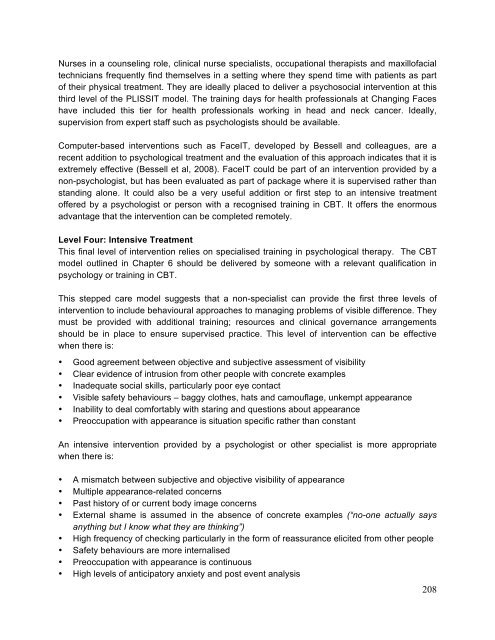Download the report - The Healing Foundation
Download the report - The Healing Foundation
Download the report - The Healing Foundation
Create successful ePaper yourself
Turn your PDF publications into a flip-book with our unique Google optimized e-Paper software.
Nurses in a counseling role, clinical nurse specialists, occupational <strong>the</strong>rapists and maxillofacial<br />
technicians frequently find <strong>the</strong>mselves in a setting where <strong>the</strong>y spend time with patients as part<br />
of <strong>the</strong>ir physical treatment. <strong>The</strong>y are ideally placed to deliver a psychosocial intervention at this<br />
third level of <strong>the</strong> PLISSIT model. <strong>The</strong> training days for health professionals at Changing Faces<br />
have included this tier for health professionals working in head and neck cancer. Ideally,<br />
supervision from expert staff such as psychologists should be available.<br />
Computer-based interventions such as FaceIT, developed by Bessell and colleagues, are a<br />
recent addition to psychological treatment and <strong>the</strong> evaluation of this approach indicates that it is<br />
extremely effective (Bessell et al, 2008). FaceIT could be part of an intervention provided by a<br />
non-psychologist, but has been evaluated as part of package where it is supervised ra<strong>the</strong>r than<br />
standing alone. It could also be a very useful addition or first step to an intensive treatment<br />
offered by a psychologist or person with a recognised training in CBT. It offers <strong>the</strong> enormous<br />
advantage that <strong>the</strong> intervention can be completed remotely.<br />
Level Four: Intensive Treatment<br />
This final level of intervention relies on specialised training in psychological <strong>the</strong>rapy. <strong>The</strong> CBT<br />
model outlined in Chapter 6 should be delivered by someone with a relevant qualification in<br />
psychology or training in CBT.<br />
This stepped care model suggests that a non-specialist can provide <strong>the</strong> first three levels of<br />
intervention to include behavioural approaches to managing problems of visible difference. <strong>The</strong>y<br />
must be provided with additional training; resources and clinical governance arrangements<br />
should be in place to ensure supervised practice. This level of intervention can be effective<br />
when <strong>the</strong>re is:<br />
• Good agreement between objective and subjective assessment of visibility<br />
• Clear evidence of intrusion from o<strong>the</strong>r people with concrete examples<br />
• Inadequate social skills, particularly poor eye contact<br />
• Visible safety behaviours – baggy clo<strong>the</strong>s, hats and camouflage, unkempt appearance<br />
• Inability to deal comfortably with staring and questions about appearance<br />
• Preoccupation with appearance is situation specific ra<strong>the</strong>r than constant<br />
An intensive intervention provided by a psychologist or o<strong>the</strong>r specialist is more appropriate<br />
when <strong>the</strong>re is:<br />
• A mismatch between subjective and objective visibility of appearance<br />
• Multiple appearance-related concerns<br />
• Past history of or current body image concerns<br />
• External shame is assumed in <strong>the</strong> absence of concrete examples (“no-one actually says<br />
anything but I know what <strong>the</strong>y are thinking”)<br />
• High frequency of checking particularly in <strong>the</strong> form of reassurance elicited from o<strong>the</strong>r people<br />
• Safety behaviours are more internalised<br />
• Preoccupation with appearance is continuous<br />
• High levels of anticipatory anxiety and post event analysis<br />
208


